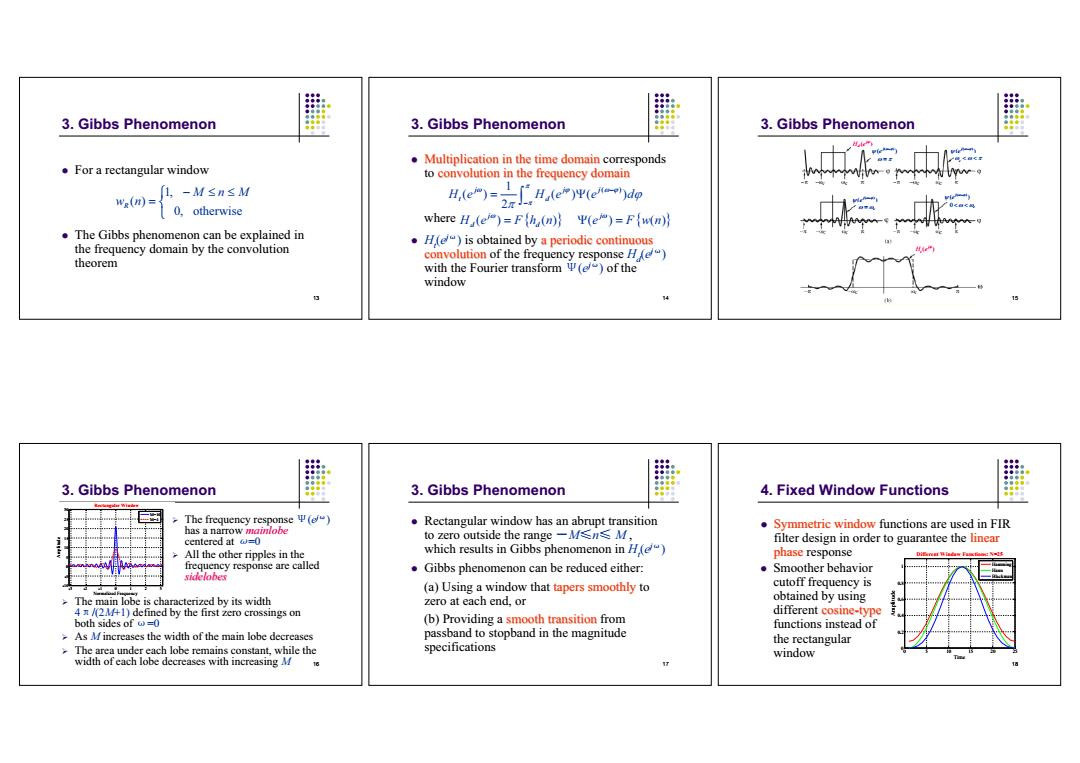正在加载图片...

3.Gibbs Phenomenon 3.Gibbs Phenomenon 3.Gibbs Phenomenon Multiplication in the time domain corresponds For a rectangular window to convolution in the frequency domain -M≤n≤M w(n)= H(e)= Aee一dp 0.otherwise where H(e)=F(h(n)Y(e)=Fw(m) .The Gibbs phenomenon can be explained in the frequency domain by the convolution 。H(e“)is obtained by a periodic continuous theorem convolution of the frequency response H") with the Fourier transform ()of the window 4 3.Gibbs Phenomenon 3.Gibbs Phenomenon 4.Fixed Window Functions The frequency response (e") Rectangular window has an abrupt transition has a narrow mainlobe Symmetric window functions are used in FIR centered at w=0 to zero outside the range -Msn M, filter design in order to guarantee the linear All the other ripples in the which results in Gibbs phenomenon in H(") phase response frequency response are called Gibbs phenomenon can be reduced either: 。Smoother behavior sidelobes (a)Using a window that tapers smoothly to cutoff frequency is The main lobe is characterized by its width zero at each end,or obtained by using 4/(2M+1)defined by the first zero crossings on different cosine-type both sides of w=0 (b)Providing a smooth transition from functions instead of >As Mincreases the width of the main lobe decreases passband to stopband in the magnitude specifications the rectangular The area under each lobe remains constant,while the window width of each lobe decreases with increasing M13 3. Gibbs Phenomenon For a rectangular window The Gibbs phenomenon can be explained in the frequency domain by the convolution theorem 1, ( ) 0, otherwise R MnM w n 14 3. Gibbs Phenomenon Multiplication in the time domain corresponds to convolution in the frequency domain where Ht(ej¹) is obtained by a periodic continuous a periodic continuous convolution of the frequency response Hd(ej¹) with the Fourier transform (ej¹) of the window 1 ( ) ( ) ( )( ) 2 j jj He H e e d t d ( ) () j H e Fh n d d ( ) () j e F wn 15 3. Gibbs Phenomenon ( ) j H e d ( ) ( ) j e ( ) ( ) j e c ( ) ( ) j e c ( ) ( ) j e 0 c ( ) j H e t 16 -3 -2 -1 0 1 2 3 -10 -5 0 5 10 15 20 25 30 Normalized Frequency Amplitude Rectangular Window M=10 M=4 3. Gibbs Phenomenon The frequency response (ej¹) has a narrow mainlobe centered at ¹=0 All the other ripples in the frequency response are called sidelobes sidelobes The main lobe is characterized by its width 4±/(2M+1) defined by the first zero crossings on both sides of ¹=0 As M increases the width of the main lobe decreases The area under each lobe remains constant, while the width of each lobe decreases with increasing M 17 3. Gibbs Phenomenon Rectangular window has an abrupt transition to zero outside the range ˉMİnİ M , which results in Gibbs phenomenon in Ht(ej¹) Gibbs phenomenon can be reduced either: (a) Using a window that tapers smoothly to zero at each end, or (b) Providing a smooth transition from passband to stopband in the magnitude specifications 18 4. Fixed Window Functions Symmetric window functions are used in FIR filter design in order to guarantee the linear phase response Smoother behavior cutoff frequency is obtained by using different cosine-type functions instead of the rectangular window 0 5 10 15 20 25 0 0.2 0.4 0.6 0.8 1 Time Amplitude Different Window Functions: N=25 Hamming Hann Blackman�����������������������